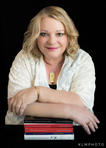What did Mary Dyer look like?
© Christy K. Robinson
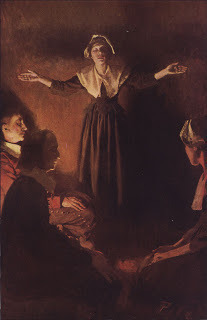 Mary Dyer at prayer, a Howard Pyle painting
Mary Dyer at prayer, a Howard Pyle paintingThe few illustrations we have of Mary Dyer, made 250-300 yearsafter her death, show a plain, slim, ageless woman in very severe clothing, herhair contained under a starched cap. No one knows what physical characteristicsshe had, though several artists have made their own interpretations, includingthe 1958 statues in Boston and Philadelphia, and the paintings of HowardPyle in the early 20th century.
In mid-17th-century Europe and England, women'sfashions were all over the board. The country women wore long, full skirts andkept their shoulders and arms covered in long-sleeved jackets. Middle-class merchants'wives also wore clothes that covered them, though they tucked their overskirtsabove their petticoats. Ladies of the court, and nobility, wore gowns of silkthat were turned back to the elbow, and revealed their bare shoulders andbosoms, right down to the areola, though for some reason, they covered theircleavage with a flower or long necklace pendant.
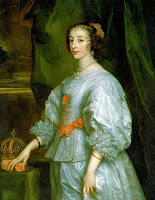 Queen Henrietta Maria, French-princess-turned-English-queen of Charles I.
Queen Henrietta Maria, French-princess-turned-English-queen of Charles I. Click to enlarge for gorgeous detail. In contrast, Queen Henrietta Maria was Catholic, anddressed more conservatively than Puritans or Anglicans. She influenced hairstyles, as we learnfrom portraits and woodcuts of other women of the day. She had ringlets around her face, andpulled her hair back with masses of ringlets behind her ears. Many women copiedthat style for formal occasions and portrait sittings. Perhaps they wore a hator cap at other times.
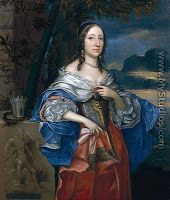 Lady Elizabeth Cromwell
Lady Elizabeth CromwellMrs. Oliver Cromwell, wife of theultra-Puritan Lord Protector of the Realm between the beheading of Charles Iand the restoration of the monarchy, is shown in a portrait wearing a colorful, expensive, low-cutgown—with pearls at her neck.
But in colonial New England, three thousand miles away fromcorrupt Babylon, men were building the NewJerusalem, the cultural Zionwhich would contain the saints of God. In this time of God's judgment, the saints ought to be dressed soberly.
Jewelry and cosmetics were forbidden in Puritan culturethroughout the 17th century, as something the wicked Jezebel would wear—or thefeared, hated Catholics, who wore crosses or saint medals, which wereinterpreted as idols or pagan amulets. (Again, note the relative lack of ornamentationon the Catholic Queen!)
Mary Winthrop Dudley, daughter and daughter-in-law ofstrict, legalistic Massachusetts governorsJohn Winthrop and Thomas Dudley, wrote letters to friends in England, lamenting the Puritan ban on stylishclothes in America.She disliked the harsh frontier life and the dress expectations placed uponher. She died in 1643, one day before her four-year-old son also died, never having returnedto Englandfor a visit.
Gold and silver embroidery were banned in 1634 Boston, as wasparticularly fancy lace. Women covered their hair with simple caps. At onepoint, the religious zealot Gov. John Endecott proposed that women wear veils,but that restriction was discarded because the women would have rebelledagainst their husbands. (You think??)
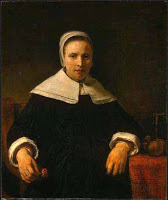 AnneDudley Bradstreet AnneDudley Bradstreet, America'sfirst poetess and daughter of the ultra-conservative Thomas Dudley, wore theclothing of a virtuous matron of high status, blackest black with plain collar and cuffs.
AnneDudley Bradstreet AnneDudley Bradstreet, America'sfirst poetess and daughter of the ultra-conservative Thomas Dudley, wore theclothing of a virtuous matron of high status, blackest black with plain collar and cuffs. Who decided what women wore? Men. But who wore lace collarsand cravats and elaborate periwigs for official occasions? Men. They pointedtheir beards as King Charles did, and dandified their mustaches, curled theirlong hair. Their silk brocade waistcoats (vests) were richly decorated withembroidery, and their wives (including Mrs. Endecott) employed lace makers tomake collars for them. Colorful ribbon rosettes tied their breeches at theknee, and tied their shoes.
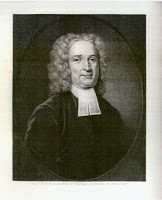 Rev. John Cotton, 1638In 1692, Rev. John Cotton's grandson, Cotton Mather (whowore a wig like his grandfather and all men of standing in the community), preached and then published a sermon called "Ornaments forthe Daughters of Zion." You can be quite sure that Rev. Mather was notexactly for ornaments! The sermonpropounded, "If a woman spends more time in dressing than in praying or inworking out her own salvation, her dress is but the snare of her soul." ByMather's time, the churches had an attendance very similar to today's mainlinechurches: two-thirds of the members were middle-aged and older women. Soperhaps the audience he intended to reach didn't get the memo.
Rev. John Cotton, 1638In 1692, Rev. John Cotton's grandson, Cotton Mather (whowore a wig like his grandfather and all men of standing in the community), preached and then published a sermon called "Ornaments forthe Daughters of Zion." You can be quite sure that Rev. Mather was notexactly for ornaments! The sermonpropounded, "If a woman spends more time in dressing than in praying or inworking out her own salvation, her dress is but the snare of her soul." ByMather's time, the churches had an attendance very similar to today's mainlinechurches: two-thirds of the members were middle-aged and older women. Soperhaps the audience he intended to reach didn't get the memo. You may have read Nathaniel Hawthorne's novel, The Scarlet Letter, in which a woman of Governor Endecott's Salem was forced to weara scarlet A for Adulteress. But did you know that in 1634, Robert Cole, "havingbeen oft punished for drunkenness, was now ordered to wear a red D about hisneck for a year." There's no record whether his scarlet letter cured hisalcoholism.
In her presentation of herself and her family, a woman had to tread a narrow course. Shewas expected to dress to meet her husband's social status. A goldsmith's ortailor's wife should enhance her husband's reputation by showing that herhusband was successful and popular in his trade, but she should never "getabove her station" by dressing like the nobility, even if she could afford it. Andshe was expected to show her husband's (not her) godliness by her manner ofdress and behavior.
Most clothes for everyday work in the home, shop, or garden wereprimary-colored, homespun, calico print, or brown, not the severe black andwhite that's been depicted in illustrations of the Pilgrims or the first colonists.Portraits were expensive, and only depicted the highest-income ormost-influential colonists, who wore black, an expensive, high-status color,with white collars, cuffs, or shirts, and no jewelry for either gender.
How did Mary Dyer appear to her associates in England and America? There are no portraits of Mary Dyer made in her lifetime,and no descriptions of her clothing styles. But because of her status as wifeof a merchant and government official, we may be confident that she waswell-dressed for each occasion, and current in fashions.When she became a Quaker, sometime in the last five to seven years of her life, she probably adopted plainer clothing, but still of high-quality material.
Here is the way Mary was described by observers: a person of no mean [inferior or low-class] extract or parentage possessing a piercing [perceptive, acute] knowledge of many things comely [pleasing in appearance] stature comely countenance [facial appearance]wonderful sweet and pleasant discoursefit for great affairscomely, grave [grounded and dignified] womanhaving a husband of great estate [political/social class, or wealth] a mother of children [eight pregnancies, six living children]goodly personage [distinction, importance]one of a good report [reputation]very proper [appropriate, fit, suitable]very fair [pretty, comely, lovely, blond, pale] woman
This suggests that Mary dressed carefully and appropriately,in what men perceived as a modest, Christian way. But it wasn't her clothingthat defined her. She was noted for her lovely character and demeanor. Surelythat was the sort of thing the apostles envisioned when they counseled women tolet their beauty come from godliness.
Iwant women to get in there with the men in humility before God, not primpingbefore a mirror or chasing the latest fashions but doing something beautifulfor God and becoming beautiful doing it. 1Timothy 2:9-10
In the end, which is more important—that we know if Mary Dyerhad blond or brown hair, if she had large green eyes, a delicate nose, or fulllips, or that she was admired for the beauty of who she was and how her selfless actions influenced people for centuries to come?
ClickHERE for images of clothing worn in the 1630s through 1650s, during MaryDyer's adulthood.
Published on September 12, 2011 21:34
No comments have been added yet.

